Ukraine’s Zelensky promises ‘no oligarchs!’ as its economy and housing market gather pace
After six years of falling house prices, Ukraine’s housing market has started to recover, despite the pandemic. Demand is recovering, despite slowing construction activity. Residential property prices, as well as land values and rents, are rising.
“With the exception of 2020, which was an outlier, demand for housing in Ukraine has been rising slowly from year to year,” said the National Bank of Ukraine in its June 2021 Financial Stability Report. “Although prices are actively increasing, housing remains reasonably affordable by historical standards because house prices and household income are growing at comparable rates.”
Even though Ukraine’s economy is now recovering – it is expected to grow by an average of 4% over the next 4 years - one must bear in mind the structural obstacles. Nowhere in Emerging Europe, where countries have adopted the Westernising approach, are oligarchs and the associated corruption as dominant as in Ukraine.
In April 2019, television comedian Volodymyr Zelensky won the presidential run-off in a landslide anti-corruption victory, which rather ignored his close friendship with his previous boss and friend, corrupt oligarch Ihor Kolomoisky. Now he is distancing himself from Kolomoisky and encouraging Congress to bring in an “oligarch law”, to block oligarchs from financing political parties, and he promises “There will be no influence on mass media, no influence on politics, no influence on officials.”
We shall see. Ukraine’s oligarchs dominate the country’s economic and political life, own political parties and television stations, and hold huge influence on judges and other high-ranking government officials.
Still, despite these structural obstacles and the fallout from the recent war, Ukraine seems to be recovering. Existing apartment prices in Kiev rose by 5.3% during the year to Q2 2021 (0.5% in real terms), to an average of US$1,087 per square metre (sq. m.) – its best showing since Q2 2013, according to S&V Development. During the latest quarter, existing apartment prices rose slightly by 0.6% (-1.7% in real terms).
Likewise, newly-built apartment prices in Kiev increased 5.2% y-o-y in Q2 2021 (0.3% in real terms), to US$975 per sq. m., also its biggest annual growth in eight years. On a quarterly basis, newly-built apartment prices rose by 0.5% in Q2 2021 (-1.8% in real terms).
Residential property prices had been falling for more than six years (Q1 2014-Q1 2020), particularly in 2014 (with prices plunging 36.6%) because of the hryvnia’s devaluation due to the Russian war.
In Q1 2021, the number of housing purchases was almost one-tenth higher than the first-quarter average for five years, according to the National Bank Ukraine. Last year, purchasing activity had dropped 7.8% from a year earlier due to the pandemic.
Demand is expected to continue rising modestly in coming years. “This growth is being propelled by the gradual revival in mortgage lending and the rapid growth in household income,” said the central bank. “Housing demand is also being whipped up by lower deposit rates, which are encouraging some of those who have significant savings to look for alternative ways to invest.”
In January 2021, the government introduced an affordable mortgage lending program to reduce the cost of mortgage loans and simplify the criteria for borrowers. The program offers an interest rate as low as 7% - significantly lower than the average interest rate for housing loans of 12% in June 2021.
“This program could boost demand for mortgages significantly,” said the central bank. “Since the banks alone bear credit risks under the program, they continue to apply their current approaches to assessing the creditworthiness of borrowers.”
There are no major restrictions on foreigners buying property in Ukraine. All secondary residential transactions (i.e., resales) are in US dollars, while primary sales are quoted in hryvnia, but still paid in dollars.
Ukraine’s overall economy is projected to grow by an average of 4% in the next three years, following a 4.2% contraction in 2020.
Land prices are rising
Land prices rose in all regions during the year to Q2 2021, according to S&V Development.
- In Kiev region, land values rose strongly by 12.4% (7.2% in real terms) y-o-y to US$1,585 per 100 sq. m. in Q2 2021
- In Odessa region, land prices soared 13.4% (8.2% in real terms) to US$2,468 per 100 sq. m.
- In Lviv region, land prices rose by 13.3% (8.1% in real terms) to US$1,021 per 100 sq. m.
- In Dnipropetrovsk region, land prices increased 8.5% (3.5% in real terms) to US$1,209 per 100 sq. m.
- In Kharkov region, land prices increased 7.1% (2.2% in real terms) to US$993 per 100 sq. m.
- In Donetsk region, land prices rose by 6.1% (1.2% in real terms) to an average of US$1,151 per 100 sq. m.
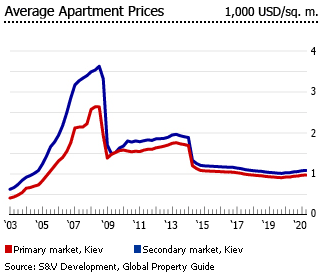
Rents are rising
Kiev apartment rents started to improve last year, after falling for seven years. During 2020, rental rates in the capital city rose by about 3.4% from a year earlier, following a total of 45% decline from 2012 to 2019, according to S&V Development.
In Q2 2021:
- For one-bedroom apartments, rents were US$284 per month, up 3.6% from Q2 2020
- For two-bedroom apartments, rents were US$384 per month in Q2 2021, up 3.8% a year earlier
- For three-bedroom apartments, rents were US$457 per month in Q2 2021, up 4.1% a year ago
The most costly location in Kiev is Shevchenkivskyi District, with rents for three-bedroom apartments of around US$612 per month in Q2 2021, followed by Pecherskyi District (US$578 per month), and Obolonskyi District (US$468 per month).

In recent years, most rent quotations have switched to the national currency, hryvnia, to protect landlords from currency fluctuations.
Residential construction is slowing
Only about 28,000 extra apartments units were added in 2020, according to the State Statistics Service– the lowest growth in five years.
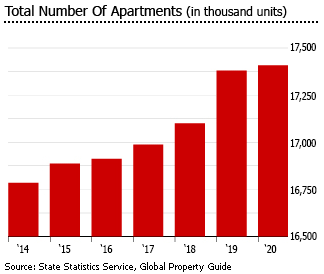
Dnipropetrovsk accounted for about 9% share of the total housing stock, followed by Kharkiv(7.3%), Donetsk (6%), Kyiv (5.7%), Lviv(5.7%), and Odesa (5.6%).
Securing construction permits has become dramatically easier
While corruption remains Ukraine’s number one problem, the ease of doing business, especially securing construction permits, has noticeably improved.
According to World Bank’s Ease of Doing Business reports, Ukraine was ranked 64 out of 190 countries in 2020 – sharply up from 71 in 2019 and from 112 in 2014. This is mainly due to a reduction in the number of mandatory licenses and permits, particularly in the construction sector, and due to a simplified tax system.
In terms of ease of obtaining construction permits, Ukraine has moved from rank 140 in 2014, to as high as rank 20 in 2020. Securing construction permits in Ukraine now requires 10 procedures, takes 72.5 days and costs 4.4% of the property value.
Despite the improvement, corruption still exists and those with direct ties to officials who are prepared to pay large bribes, usually come out winners in land allocations. So it is not surprising that there are only a few builders in the market. New developments in major cities are typically dominated by two to three companies, whose management is directly linked to the local authorities.
In Kiev, nearly 70% of the new residential buildings are built by companies that belong to the KyivMiskBud holding company, in which the Kyiv City State Administration has a large stake.
Interest rates continue to fall
In June 2021, the average interest rate for housing loans stood at 12%, down from 15.3% a year earlier and 18.3% two years ago, according to the National Bank of Ukraine.
By currency:
- Interest rates on US$-denominated housing loans, which account for about half of total housing loans, averaged 7.6% in June 2021, slightly up from 7.2% in June 2020 but down from 9.4% two years ago.
- The average interest rate on hryvnia-denominated housing loans, which represent about 45% of total housing loans, was 12% in June 2021, down from 15.6% in June 2020 and 18.7% in June 2019.
- The average interest rate on euro-denominated housing loans also fell to 5.1%, from 8.1% a year ago.
Interest rates on housing loans in Ukraine are usually fixed for the entire loan term. In June 2021, more than 94% of housing loans had loan terms of 5 years or more, and about 74% of those were loans for 10 years or more.
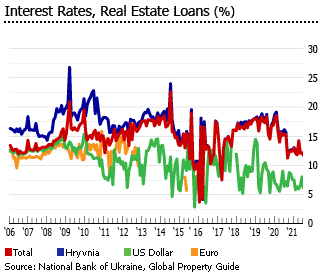
However, housing loans are frequently prepaid before maturity, and it is not uncommon that a 10-20 year loan to be paid within 3 - 5 years.
“Nowadays homebuyers seek loans instead of traditional long-term mortgages, opting for bridge financing where they already have 80-90% of a property’s value in cash and intend to repay their loan in 6-12 months,” says Vestor.Estate’s co-founder Tim Louzonis.
The mortgage market has been shrinking
From its peak of 10.8% of GDP in 2009, Ukraine’s mortgage market has shrunk to less than 1% of GDP in 2020 – and despite the recent decline in interest rates, total outstanding loans for house purchases fell sharply during the year to June 2021 by 18.3% y-o-y to UAH 28.39 billion (US$1.06 billion), according to the central bank.
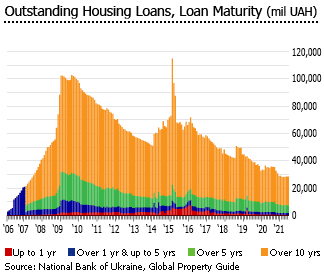
By original maturity:
- Up to 1 year: housing loans were down 56.6% y-o-y to UAH 299 million (US$11.15 million) in June 2021
- 1-5 years: housing loans fell by 22.8% y-o-y to UAH 1.35 billion (US$50.43 million) over the same period
- 5-10 years: loans fell by 21.2% y-o-y to UAH 5.7 billion (US$212.39 million) in June 2021
- Over 10 years: loans fell by 16.2% y-o-y to UAH 21.04 billion (US$784.23 million) in June 2021
By currency:
- US$-denominated housing loans were down by 36.6% y-o-y to UAH 14.25 billion (US$531 million) in June 2021
- Hryvnia-denominated housing loans increased 21.1% y-o-y to UAH 12.88 billion (US$480 million) in June 2021
- Euro-denominated housing loans fell by 23% y-o-y to UAH 567 million (US$21.1 million)
- Housing loans denominated in other currencies fell by 23.6% y-o-y to UAH 700 million (US$26.1 million) in June 2021
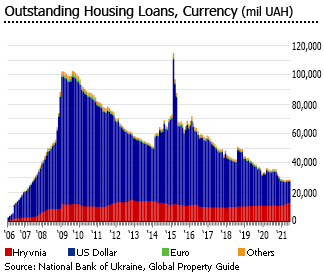
The dark years of crisis and war – and then recovery
Ukraine enjoyed an economic boom during the decade 2000-2007 with an average GDP growth of 8% per year, setting off a massive property boom. The hryvnia rose because of the economic growth and foreign investment, but inflation and interest rates began to rise too.
The logical conclusion was – borrow dollars on low interest rates, buy Ukrainian property as it rises, then sell and repeat. Easy money.
For a long time it worked. The hryvnia appreciated as economic growth accelerated, and as foreigners invested in Ukraine. The country lived off its massive steel industry (42% of exports). Foreign buyers – Britons, Americans, Emiratis, Cypriots, Kiwis and Canadians – as well as wealthy elite Ukrainians, pushed house prices up by an average of 40% to 55% p.a. from 2004 to 2007. In fact, property prices rose by a total of 442% from 2002 to 2007 (373% in real terms).
Currency inflows increased the money supply excessively, resulting in inflation. Ukraine experienced double-digit inflation from 2004 onwards, and in May 2008 inflation peaked at 31% y-o-y. As a result, Ukraine priced itself out of export markets, imports grew much bigger than exports, and the current account deficit expanded to 7% of GDP in 2008.
As the contagion from the global financial crisis spread in 2008, the hryvnia lost over 50% of its value against the US dollar, leading to a loss of consumer confidence in banks and mass withdrawals. Depositors rushed to withdraw their savings from banks and the government was forced to unveil a bank bailout.
Meanwhile, demand for Ukraine’s main product, steel, plummeted. Ukraine’s GDP contracted 15.1% in 2009.
The orange revolution of 2004, and the election of Yanukovych
On top of this came political chaos. The country’s tragedy is that the Orange Revolution of 2004, which resulted in a clear victory for the Western-oriented Viktor Yushchenko (with 52% votes) over the pro-Russian Viktor Yanukovych, never bore fruit. Yushchenko proved an ineffective leader. He quarreled deeply with his former ally Tymoshenko, who he saw as corrupt and accused of being a covert friend of Russia.
The result of the split in the pro-Western party was the election of a pro-Russian president, Victor Yanukovych, who decided to put off an association agreement with the European Union (EU), which would have provided funds contingent on reforms. Instead, Yanukovych signed an agreement with Russia, which eventually led to his ouster as president in February 2014. He was temporarily succeeded by Oleksandr Turchynov.
Following Yanukovych’s ouster, protests by pro-Russian and anti-revolution activists escalated into an armed conflict between the Ukrainian government and the separatist forces of the self-declared Donetsk and Luhansk People’s Republics.
Russia subsequently seized Crimean peninsula and launched insurgency to occupy parts of eastern Ukraine. A ceasefire - the Minsk Protocol - was reached in September 2014, but collapsed in January 2015. In February 2015, a new ceasefire agreement, Minsk II, was signed – but unfortunately, has never been implemented. Thousands have been killed in the past five years.
The political crisis adversely affected the economy, which contracted by 0.03% in 2013, 6.6% in 2014 and by another 9.8% in 2015.
The election of pro-European president Poroshenko, and the floating of hryvnia
Amidst the conflict, Petro Poroshenko, a pro-European chocolate tycoon, emerged victorious in the May 2014 Presidential elections, and in October 2014 his party obtained the majority of seats (132 seats) in parliament.
In February 2014 the National Bank of Ukraine announced that they would set a floating exchange rate in accordance to IMF’s requirements. This resulted in an around 70% depreciation of the hryvnia against the US dollar in 2014 and 2015. In 2016 the depreciation of Ukrainian hryvnia continued, and it traded at an average of UAH 25.5 = US$1 in 2016, a decline of around 80% on the previous year. This had a catastrophic effect, as a large proportion of housing loans are denominated in US$, and were now impossible to repay. Out of Ukraine’s total outstanding housing loans, only 17% were denominated in UAH by end of 2016, while 79% of loans were denominated in US dollars.
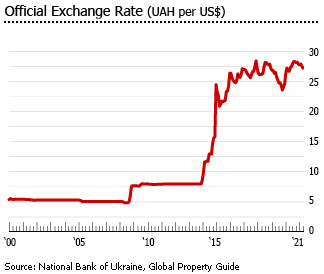
In the past four years, the currency has been more stable, with the average monthly exchange rate at UAH 27.24 per US$1 on June 2021, a slight depreciation from from UAH 26.71 per US$1 in June 2020 and UAH 26.5 per US$1 in June 2019. The currency’s recent stability is mainly attributed to the central bank’s stabilization measures.
The economy returned to growth after three years of turmoil. The economy expanded by 2.4% in 2016, 2.5% in 2017, 3.3% in 2018 and by another 3.2% in 2019.
The election of another pro-European president Zelensky, and his goal for ‘de-oligarchization’
However voters were tired of the continued conflict with Russia and tired of the continual dominance of Ukrainian politics by corrupt links between oligarchs and politicians.
In April 2019, television comedian Volodymyr Zelensky won the presidential run-off in a landslide victory over Poroshenko. Despite the fact that Zelenskiy has never held any elected office before, voters were willing to take a risk.
In his inaugural address, Zelensky vowed to end the Russian-backed insurgency in the east of the country and announced early parliamentary elections in an effort to capitalize on his popularity.
In September 2019, Russia and Ukraine swapped prisoners captured in the wake of Moscow’s seizure of Crimea and intervention in the Donbass, a move that shows both countries’ willingness to engage in peace negotiations. In December 2019, Zelensky met Russian President Vladimir Putin for the first time and agreed to implement a complete ceasefire in eastern Ukraine by the end of 2019.
However like Poroshenko, President Zelensky is also pushing for Ukraine’s membership to both the European Union (EU) and the North Atlantic Treaty Organization (NATO) – a move that has been strongly opposed by Kremlin.
But two years after assuming office Zelensky’s popularity is now slipping. A problem is his previous friendship with oligarch Ihor Kolomoisky, who had fled to exile in Israel after a $5.6 billion hole in the ledgers of the bank he had founded. Kolomoisky owns the media station Zelensky worked for, backed his election campaign, and appears to have socialized with him, drunk with him, and been visited abroad by him no less than 13 times while Zelensky was a candidate.
To regain public support, Zelensky is seen renewing its commitment to its reformist platforms and end the country’s oligarchic system. Publicly Zelensky has now severed all connection with Kolomoisky. And in March 2021, the US, with Zelensky’s blessing, barred Kolomoisky and his immediate family from entering the country.
Recently, Zelensky mandated the National Security and Defence Council to draft a list of 13 as yet unnamed oligarchs. Then in July 1, the Congress approved in the first reading a draft bill known as “the oligarch law”, which aims to introduce a legal definition for an oligarch and impose limitations, including blocking them from financing political parties.
“There will be no influence on mass media, no influence on politics, no influence on officials,” said Zelensky. “But if there is influence, then these people will get a ticket called ‘oligarch’. They will be included in a special register, and then this big business may lose a great share of its assets.”
Despite Zelensky’s ambitious plan, many doubt whether he can actually deliver his promises.
Economy to rebound, inflation accelerating again
Ukraine’s economy contracted by 4.2% during 2020, following annual expansions of 3.2% in 2019 and 3.4% in 2018. This year Ukraine’s economy is set to rebound, with real GDP growth forecast at 4% by the International Monetary Fund (IMF).
“Consumer demand will continue to be its main driver. The gradual revival in investment activity as the global economy recovers and the pandemic subsides will also contribute to economic growth,” said the National Bank of Ukraine.
Though major risks to Ukraine’s return to growth are the country’s slow progress on reform and vaccination, as well as the reimposition of quarantine measures.
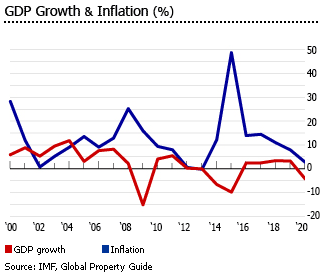
Last year the IMF approved an 18-month US$5 billion standby arrangement for Ukraine to help cope with the coronavirus pandemic.
The country is expected to record a current account deficit of 0.4% of GDP this year, mainly driven by increasing domestic demand, improving tourism, and higher dividend payments. The deficit will widen further in the coming years as a result of continued growth in domestic demand.
Nationwide inflation accelerated to 9.5% in June 2021, sharply up from just 2.4% a year earlier, amidst rising global food and petroleum prices, according to the NBU. Inflation slowed to 2.7% last year, from an annual average of 18% from 2014 to 2019.
Rapidly rising consumer prices prompted the central bank to raise its key policy rate to 8% in July 2021, its third rate hike this year, and it has signalled another hike was likely to keep a lid on rising prices.
Unemployment remains high at 10.5% in Q1 2021, up from 10.1% in the previous quarter and 9.9% a year earlier, according to State Statistics Service.
Sources:
- Apartment prices (housing prices) (S&V Development): http://www.svdevelopment.com/ru/web/flat_costs/
- Apartment rental prices (S&V Development): http://www.svdevelopment.com/ru/web/rent/
- External Sector Statistics (National Bank of Ukraine): https://bank.gov.ua/en/statistic/sector-external/data-sector-external#6
- Financial Sector Statistics (National Bank of Ukraine): https://bank.gov.ua/en/statistic/sector-financial/data-sector-financial#1ms
- NBU Key Policy Rate (National Bank of Ukraine): https://bank.gov.ua/en/monetary/stages/archive-rish
- Ease of Doing Business rankings (World Bank): https://www.doingbusiness.org/en/rankings
- Ukraine Doing Business 2020 (World Bank):https://www.doingbusiness.org/content/dam/doingBusiness/country/u/ukraine/UKR.pdf
- At the initiative of the Head of State, the government approved a resolution on affordable mortgages within 7% per annum (President of Ukraine Official Website): https://www.president.gov.ua/en/news/z-iniciativi-glavi-derzhavi-uryad-zatverdiv-postanovu-pro-do-66201
- Ministry of Finance: Under the decision of the Government, "Affordable Mortgage at 7%" becomes even more affordable (Government Portal): https://www.kmu.gov.ua/en/news/minfin-rishennyam-uryadu-dostupna-ipoteka-pid-7-staye-shche-dostupnishoyu
- Ukraine profile – Timeline (BBC News): https://www.bbc.com/news/world-europe-18010123
- Ukraine country profile (BBC News): https://www.bbc.com/news/world-europe-18018002
- The stable crisis. Ukraine’s economy three years after the Euromaidan (Centre for Eastern Studies): https://www.osw.waw.pl/en/publikacje/osw-commentary/2017-04-05/stable-crisis-ukraines-economy-three-years-after-euromaidan#_ftnref3
- Zelensky v oligarchs: Ukraine president targets super-rich (BBC News): https://www.bbc.com/news/world-europe-57198736
- Zelensky’s fall from grace (Global Risk Insights): https://globalriskinsights.com/2021/02/zelenskys-fall-from-grace/
- Zelenskiy´s ´De-Oligarchization´ Goal Important, Path To Success ´Difficult,´ U.S. Official Says (Radio Free Europe): https://www.rferl.org/a/zelenskiy-george-kent-ukraine/31375306.html
- Ukraine At a Glance (International Monetary Fund): https://www.imf.org/en/Countries/UKR
- New EBRD forecast sees Ukraine’s economy returning to growth (European Bank for Reconstruction and Development): https://www.ebrd.com/news/2021/new-ebrd-forecast-sees-ukraines-economy-returning-to-growth-.html
- Ukrainian Economy to Grow by about 4% Annually in 2021–2023, Inflation to Begin to Slow in Autumn of 2021 – Inflation Report (National Bank of Ukraine): https://bank.gov.ua/en/news/all/ukrayinska-ekonomika-u-20212023-rokah-zrostatime-tempami-na-rivni-blizko-4-a-inflyatsiya-pochne-spovilnyuvatisya-voseni-2021-roku--inflyatsiyniy-zvit
- IMF Executive Board Approves 18-month US$5 Billion Stand-By Arrangement for Ukraine (International Monetary Fund): https://www.imf.org/en/News/Articles/2020/06/09/pr20239-ukraine-imf-executive-board-approves-18-month-us-5-billion-stand-by-arrangement
- Ukraine Unexpectedly Raises Rates, Signals Another Hike to Come (Bloomberg): https://www.bloomberg.com/news/articles/2021-07-22/ukraine-to-extend-rate-pause-as-prices-level-off-decision-guide
- Financial Stability Report June 2021 (National Bank of Ukraine): https://bank.gov.ua/admin_uploads/article/FSR_2021-H1_eng.pdf?v=4